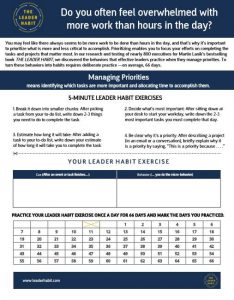More Work Than Hours in the Day? Learn How to Manage Priorities
You may feel like there always seems to be more work to be done than hours in the day, and that’s why it’s important to prioritize what is more and less critical to accomplish. Prioritizing enables you to focus your efforts on completing the tasks and projects that matter most. Without clear priorities, you will struggle to get anything done because everything will seem equally important and you won’t know how to spend your time and energy most effectively.
Managing priorities means identifying which tasks are most important and allocating appropriate time to accomplish them. In our extensive research and testing of nearly 800 executives for my bestselling book THE LEADER HABIT, my team and I discovered the micro-behaviors that effective leaders do when they manage priorities. They:
- Break down the larger project into smaller tasks and assignments that are clear, concrete, and actionable, so that everyone knows exactly what to do.
- Divide the tasks into more and less critical pursuits, e.g., identifying what needs to get done straightaway vs. what can wait until tomorrow.
- Look at each task and assignment and estimate how long it will take to accomplish; the time estimates are realistic and comfortably achievable.
- Base priorities on a solid, logical rationale, so that everyone understands why a particular task is more important than others.
Once you understand that these behaviors are the key to managing priorities, you will need to internalize them for yourself, turning them into habits. Based on our finding that it takes 66 days to turn a behavior into a habit, we have created four simple exercises that will help you improve your ability to manage priorities. They are:
Exercise #1: Break down projects into tasks
Although you probably won’t start a new project every day, you can get in the habit of breaking down your daily tasks into smaller action items using this exercise: After picking a task from your to-do list, write down two or three things you need to do to complete the task. For example, if one of your tasks today is to create a presentation, your two action items could be to create the slides and then write the speaker notes.
Exercise #2: Divide your tasks into more and less critical pursuits.
You can get in the habit of doing this behavior by starting your workday with this simple exercise: After sitting down at your desk to start your workday, write down the two or three most important tasks you must complete that day. Of course, you should work on these tasks before anything else.
Exercise #3: Allocate appropriate time for completing your work.
This micro-behavior requires you to make an accurate estimate of how much time it will take you to complete a given task. Without accurate time estimates, it is difficult to plan your work and complete it on schedule. To turn this behavior into a habit, practice this exercise: After adding a task to your to-do list, write down your estimate of how long it will take you to complete the task. For example, you might estimate that it will take thirty minutes to draft an email informing your team about a new client project.
Exercise #4: Be clear why something is a priority.
When prioritizing projects or tasks, make your rationale for the decision clear to yourself and others on your team. Use the following exercise to practice this micro-behavior on a daily basis: After describing a project (in an email or a conversation), briefly explain why it is a priority by saying, “This is a priority because …” For example, you may prioritize a project because it is for your largest customer.
At work, managing priorities well is crucial to implementing a new strategy or aligning your team with an existing strategy. Implementation of any strategy involves translating the abstract strategy into concrete, actionable steps for people and teams to execute. If you cannot readily break down the strategy into smaller tasks or cannot prioritize such tasks, you will struggle to bring your team’s activities and resources into line with the organization’s planned objectives. The same is true for situations when you are charged with improving products and services, as such initiatives also rely on your ability to manage priorities.
Ready to take the next step? Click the image below to download your complimentary 66-day skill worksheet.
Get THE LEADER HABIT at Amazon
Next Post ›

